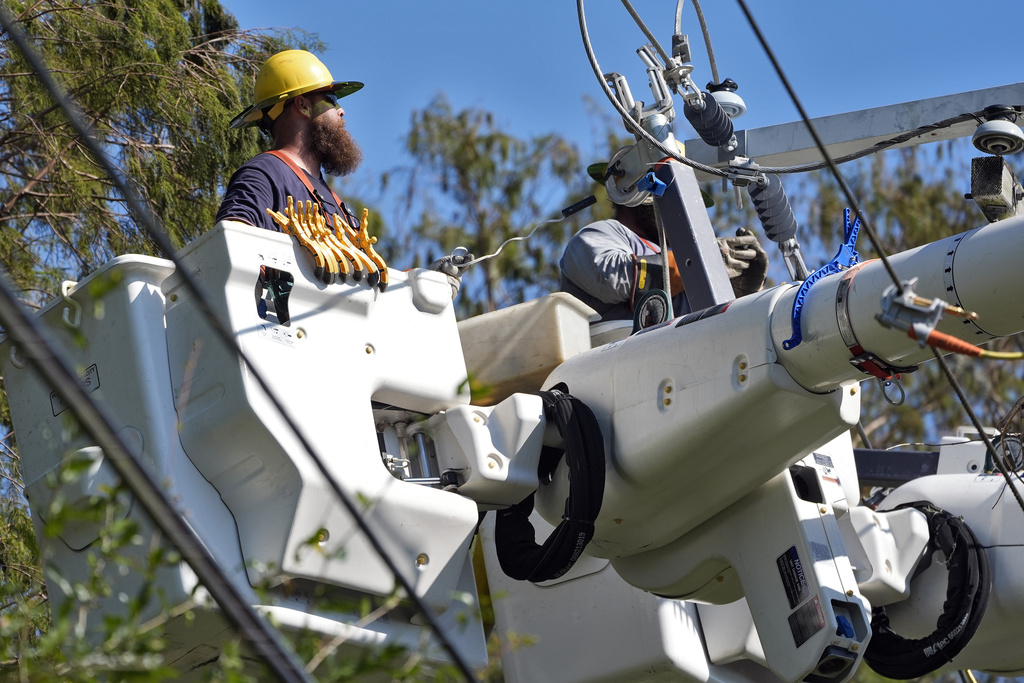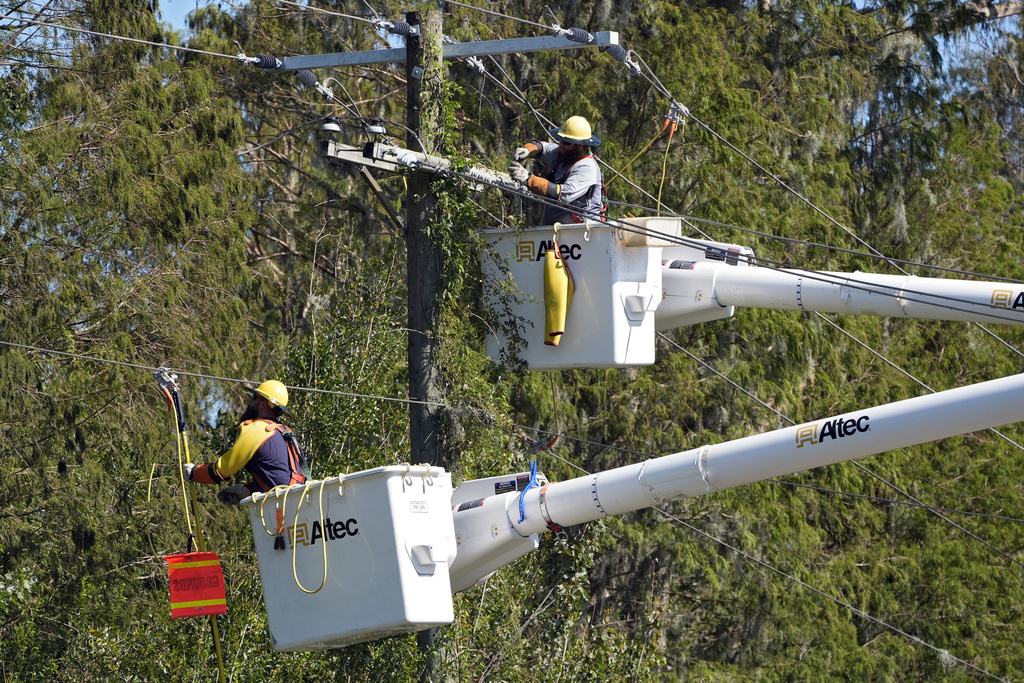FL Begins Recovery After Milton, Power Restored to Most Areas \ Newslooks \ Washington DC \ Mary Sidiqi \ Evening Edition \ Florida is beginning to recover from Hurricane Milton, with power restored to nearly 90% of the 3.4 million homes and businesses initially affected. While gas stations are reopening and schools are preparing to resume classes, some severely damaged neighborhoods remain without power. The recovery effort continues as utility workers, local officials, and residents rebuild from both Hurricane Milton and the earlier Hurricane Helene.

Florida Recovery Post-Hurricane Milton: Quick Looks
- Power restoration: 90% of homes and businesses have power, with full restoration expected for most by Tuesday.
- Ongoing damage: Flooded neighborhoods, downed power lines, and debris continue to hinder recovery in the hardest-hit areas.
- Governor’s remarks: Gov. Ron DeSantis praised the rapid recovery but warned that full debris removal could take up to a year.
- School reopenings: Most schools in affected counties plan to reopen this week, while some are still cleaning up debris and standing water.
- Economic impact: Hurricane Milton, combined with damage from Hurricane Helene, could result in $35 billion to $55 billion in privately insured losses.
Deep Look
Florida is slowly returning to normal after Hurricane Milton, which caused widespread destruction when it made landfall south of Tampa last Wednesday. The Category 3 storm brought winds of 120 mph (205 kph) and a storm surge of up to 10 feet (3 meters), leaving significant damage in its wake and disrupting lives across the state. By Monday afternoon, Florida power companies had restored electricity to nearly 90% of the 3.4 million customers who lost service during the storm. However, the full recovery for some of the hardest-hit areas, particularly those still experiencing flooding and severe property damage, will take time.
As Florida rebuilds, gas stations that had run out of fuel ahead of the storm are gradually reopening. Governor Ron DeSantis confirmed that the state had brought in 12 million gallons of fuel over the past four days, double the usual amount, to help replenish supplies. Lines at gas stations have mostly dissipated, though areas like the Tampa Bay region are still catching up. According to GasBuddy, about half of the gas stations in the area had fuel by Monday afternoon, a marked improvement from Friday when less than a quarter were stocked.
Governor DeSantis addressed the recovery effort at a news conference on Monday, held at SeaPort Manatee, south of Tampa Bay. He praised the rapid restoration of power and credited Florida’s investments in infrastructure improvements over the last decade. These efforts, which include placing more power lines underground and installing stronger utility poles, have helped speed up the recovery process. “I know those guys got in and started working as soon as it was possible,” DeSantis said, referring to utility workers. “The recovery has been very rapid, and we appreciate what they’ve been able to do.”
Florida’s three major power companies—Florida Power & Light, Duke Energy, and TECO Energy—reported that they expect to have power restored to over 95% of customers by Tuesday night. Thousands of workers have been deployed across the state to repair damaged lines and poles. However, areas still experiencing flooding, as well as homes with damaged electrical systems, will be the last to regain power. “Electricity and water don’t mix, so we cannot reenergize until the water has receded to ensure the safety of those customers,” Duke Energy spokesperson Ana Gibbs explained.
For some residents, like Gerome Ozias of Palmetto, the return of power came sooner than expected. After being without electricity for four days, Ozias was pleasantly surprised when his lights came back on Sunday night. Sitting on his front porch with his family, he expressed relief. “I’m surprised, but I’m happy, too,” Ozias said, having already replaced the food that had spoiled in his refrigerator.
While power has been restored to many neighborhoods, other communities are still struggling with extensive damage. In Ellenton, just south of Palmetto, retiree Chuck Porter and his neighbors remained without power on Monday afternoon. A snapped power pole lay across a yard, and a large tree, uprooted by the storm, had taken down power lines. Utility trucks passed through the area but couldn’t make repairs due to the ongoing flooding. Despite the challenges, Porter remained optimistic. “By the end of the week, we’ll be fine,” he said.
Porter’s home, like many others, had suffered severe water damage during Hurricane Helene just weeks earlier. Although Milton’s winds knocked out power and caused roof damage, it was the flooding from Helene that left Porter’s house knee-deep in muck. The saltwater from the storm surge destroyed appliances, wiring, and light sockets. Porter had already begun the laborious process of replacing his refrigerator, air conditioner, and other electrical systems, but he acknowledged that full recovery could take months. “Saltwater just destroys everything,” Porter said, noting that neighbors closer to the river had it even worse, with sewage flooding their homes.
The rebuilding process will be long and costly. Moody’s estimates that the combined privately insured losses from Hurricanes Helene and Milton could range between $35 billion and $55 billion. This figure does not include damage covered by the federal flood insurance program, which is likely to add significantly to the total cost. The federal government has approved 100% reimbursement for debris removal for the next 90 days, and Florida has mobilized nearly 3,000 workers to help with cleanup efforts.
The economic impact of the storms extends beyond property damage. In the days before Milton’s landfall, many businesses had to close, and fuel shortages caused long lines at gas stations. David Washington, a lifelong Floridian, was one of many residents driving through soggy, storm-battered neighborhoods to check on friends and family. On Monday, he was at a Palmetto car wash, drying his mud-spattered Ford F-150. “You clean your car and get inside, it just makes you feel so much better,” Washington said, grateful for small victories amid the ongoing recovery.
Meanwhile, schools in the hardest-hit areas are preparing to reopen. In Hillsborough County, which includes Tampa, school staff and community volunteers spent Monday cleaning up debris from campuses. Tanya Arja, a spokesperson for the district, noted that about a third of the district’s 304 schools were still without power, and a dozen schools still had standing water. Despite these challenges, most schools are aiming to reopen on Wednesday. Manatee County, just south of Tampa, plans to resume classes on Tuesday.
Governor DeSantis has cautioned that the full recovery from both Helene and Milton could take up to a year. The combination of wind, water, and flooding damage has left some neighborhoods devastated, particularly in low-lying coastal areas. “It’s going to be like this for six months or more” before everything gets repaired, Porter predicted. Insurance will cover much of the cost, he added, but the process will be slow and time-consuming.
As Florida begins to recover from the twin impacts of Helene and Milton, the resilience of its residents and the effectiveness of its infrastructure improvements will continue to be tested. For now, the focus remains on restoring power, clearing debris, and returning to daily life, even as the memory of the storms lingers.
FL Begins FL Begins FL Begins FL Begins







